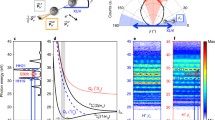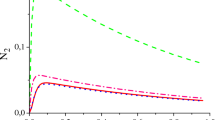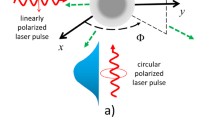Abstract
The dynamics of photoexcitation of the hydrogen atom in the discrete and continuous spectra under the action of laser pulses in the attosecond range of time and pulse durations has been analyzed using perturbation theory. It is shown that over time interval shorter than or on the order of pulse duration, the time dependence of the photoexcitation probability is generally oscillating by nature. It has been established that for certain values of parameters, the envelope of this dependence has a peak, the position of which is determined by the pulse duration and carrier frequency.







Similar content being viewed by others
REFERENCES
M. Hassan, A. Wirth, I. Grguras, et al., Rev. Sci. Instrum. 83, 111301 (2012).
F. Krausz and M. Ivanov, Rev. Mod. Phys. 81, 163 (2009).
T. Gaumnitz, A. Jain, Y. Pertot, et al., Opt. Express 25, 27506 (2017).
A. V. Gets and V. P. Krainov, Contrib. Plasma Phys. 53, 140 (2013).
F. B. Rosmej, V. A. Astapenko, and V. S. Lisitsa, Phys. Rev. A 90, 043421 (2014).
V. A. Astapenko and N. N. Moroz, J. Exp. Theor. Phys. 127, 58 (2018).
V. A. Astapenko, V. S. Lisitsa, and A. V. Yakovets, J. Exp. Theor. Phys. 127, 1003 (2018).
V. Gruson, L. Barreau, A. Jimenez-Galan, et al., Science (Washington, DC, U. S.) 354, 734 (2016).
A. Kaldun, A. Blattermann, V. Stooß, et al., Science (Washington, DC, U. S.) 354, 738 (2016).
V. Prasad, B. Dahiya, and K. Yamashita, Phys. Scr. 82, 055302 (2010).
V. Prasad, private commun.
V. A. Astapenko, Phys. Lett. A 374, 1585 (2010).
Q. Lin, Jian Zheng, and W. Becker, Phys. Rev. Lett. 97, 253902 (2006).
V. B. Berestetskii, E. M. Lifshitz, and L. P. Pitaevskii, Course of Theoretical Physics, Vol. 4: Quantum Electrodynamics (Nauka, Moscow, 1989; Pergamon, Oxford, 1982).
V. A. Astapenko, The Interaction of Electromagnetic Pulses with Classical and Quantum Systems (MFTI, Moscow, 2013) [in Russian].
Funding
This study was performed under State assignment no. 3.9890.2017/8.9 of the Ministry of Education and Science of the Russian Federation.
Author information
Authors and Affiliations
Corresponding author
Additional information
Translated by N. Wadhwa
APPENDIX
APPENDIX
We can write the following expression for the photoexcitation probability under the action of field E(t) (we assume that E(t → ±∞) = 0) in the dipole approximation in the first order of perturbation theory:
Angle brackets indicate averaging over the initial state of the target.
Expression (A.1) contains the dipole moment correlator (DMC) that can be written for a stationary system in form
This gives
Passing to the Fourier transform of the DMC, we obtain
Using the relation between the DMC and the photoexcitation cross section [15], we obtain
After simple transformations
and
we pass to formula (1):
Rights and permissions
About this article
Cite this article
Astapenko, V.A. Attosecond Dynamics of Photoexcitation of the Hydrogen Atom by Ultrashort Laser Pulses. J. Exp. Theor. Phys. 130, 56–61 (2020). https://doi.org/10.1134/S1063776119120124
Received:
Revised:
Accepted:
Published:
Issue Date:
DOI: https://doi.org/10.1134/S1063776119120124




